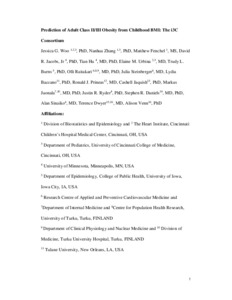Prediction of adult class II/III obesity from childhood BMI: the i3C consortium
Dwyer T.; Venn A.; Zhang N.; Woo J.; Jacobs D.; Fenchel M.; Urbina E.; Hu T.; Raitakari O.; Burns T.; Bazzano L.; Steinberger J.; Jaquish C.; Prineas R.; Ryder J.; Juonala M.; Sinaiko A.; Daniels S.
https://urn.fi/URN:NBN:fi-fe2021042825206
Tiivistelmä
Background and objectives: Adult class II/III obesity (BMI ≥ 35 kg/m2) has significant adverse health outcomes. Early prevention and treatment are critical, but prospective childhood risk estimates are lacking. This study aimed to define the prospective risk of adult class II/III obesity, using childhood BMI.
Methods: Children ages 3–19 years enrolled in cohorts of the International Childhood Cardiovascular Cohort (i3C) consortium with measured BMI assessments in childhood and adulthood were included. Prospective risk of adult class II/III obesity was modeled based on childhood age, sex, race, and BMI.
Results: A total of 12,142 individuals (44% male, 85% white) were assessed at median age 14 [Interquartile range, IQR: 11, 16] and 33 [28, 39] years. Class II/III adult obesity developed in 6% of children with normal weight; 29% of children with overweight; 56% of children with obesity; and 80% of children with severe obesity. However, 38% of the 1440 adults with class II/III obesity (553/1440) were normal weight as children. Prospective risk of adult class II/III obesity varied by age, sex, and race within childhood weight status classifications, and is notably higher for girls, black participants, and those in the United States. The risk of class II/III obesity increased with older adult age.
Conclusions: Children with obesity or severe obesity have a substantial risk of adult class II/III obesity, and observed prospective risk estimates are now presented by age, sex, race, and childhood BMI. Clinical monitoring of children’s BMI for adult class II/III obesity risk may be especially important for females and black Americans.
Kokoelmat
- Rinnakkaistallenteet [27094]
